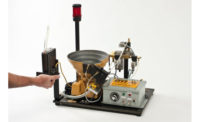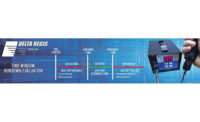People are imperfect, but, on occasion, they can perfectly perform a complex task. A pitcher can toss a perfect game in baseball. A gymnast can earn a 10.0 in international competition. A student can ace an exam.
In the world of assembly, workers rely on specially designed tools and equipment to consistently perform error-free work. Manual, pneumatic and electric screwdrivers are the tools of choice where fastening is concerned.
“Error-proof screwdriving became more commonplace in the 1970s with the advent of DC tools,” explains Dave Cash, marketing application specialist at Mountz Inc. “The goal of error-proofing is to both prevent mistakes and catch them. These mistakes primarily involve missing fasteners in a product or subassembly, and improperly installed fasteners in the joint.”
Two years ago, Mountz helped a global electronics contract manufacturer document the torque level applied to every screw used to install PCBs in servers and routers. Some of the boards being assembled cost upwards of a million dollars apiece.
Up to that point, documentation compliance was the duty of each assembler. The problem was, the assembler sometimes let go of the tool before the correct torque value was reached, and occasionally used an incorrect bit.
To ensure that each fastener is tightened to the right torque, the manufacturer uses Mountz MD-Series DC screwdrivers and the MDC Controller for data collection. As for the latter problem, Mountz developed a Bit Socket Tray with sensors to detect a different color tape wrapped around each bit. The tray directly connects to the controller.
Now, when a PCB arrives, the assembler scans the bar code on the base. This indicates which color bit he should take from the four-position tray. When the right bit is attached, the screwdriver is automatically set to the correct torque specs. If the incorrect bit is selected or no bit is attached, the tool has no power, thereby preventing assembly errors.
Mountz’s smart socket tray is one example of how assemblers and tool suppliers are using technology to error-proof fastening. For consistent error-free fastening, engineers must address every aspect of the assembly process, including the tool, the fastener and the parts.
Tool-Focus Time
Tool selection is the most important factor for error-proof screwdriving. Manual options include preset and adjustable screwdrivers. Torque-limiting screwdrivers have been used since 1961, when Richmont company founder Frank Livermont patented the tool. His model featured a limited-slip clutch, whereas most of today’s torque screwdrivers feature a torque-limiting clutch that disengages once the proper torque has been reached. Low-, mid- and high-torque range screwdrivers are available.
“The great things about the manual torque-limiting screwdriver are its simplicity, accuracy and reliability,” notes John Reynertson, president of Sturtevant Richmont. “The operator simply presets it to a specific torque and installs the screw. An internal mechanism prevents the screwdriver from overtorquing the fastener, and a light or sound signals to the operator when the proper torque is reached.”
Four types of manual preset torque screwdrivers are most commonly used in assembly: the limited-slip, cam-over, dial-indicating and digital. The latter are increasing in popularity as the need for fastening data increases. Torque on all of these screwdrivers is preset with a torque tester.
Manufacturers typically use preset torque screwdrivers in applications where one torque setting is required and engineers need to prevent incidental or deliberate changes to the setting. However, if the torque specification changes or a new project requires a different torque setting, the screwdriver is still flexible enough that a new torque can be set internally using a torque analyzer.
Adjustable torque screwdrivers offer different setting options for applications that require more than one torque value. They feature an external adjustment scale, as well as a ring or bezel device. The operator simply presses the device down to adjust the torque setting and lock it into place to prevent incidental torque adjustment.
All screwdrivers made by Sturtevant Richmont are hand-operated and best suited for low- and mid-volume production. Reynertson notes, though, that manufacturers and design engineers should always make error-proofing each fastened joint a priority, regardless of production level or product complexity. Accurate tools are essential to achieve this goal.
In 2019, Sturtevant Richmont introduced the Exacta 1350-TD Torque Driver series of digital torque and angle screwdrivers. For error-proof screwdriving, these hand-operated tools must be used with the company’s Global 400 and Global 400mp process monitors. The tools wirelessly connect to either monitor, which then disables the tool keypad to prevent inadvertent operator changes to torque parameters.
Tool operation is simple. The assembler simply applies the tool (having a 1/4 inch male square or female hex drive) to the screw head and follows step-by-step assembly directions shown on the monitor display. There are no buttons to push on the tool.
When the fastener approaches minimum torque, the light band on the monitor turns yellow. A green light and a short beep indicate an error-proof installation. Exceeding maximum torque causes the light to turn red and the audible beep to change to one long tone.
Detailed torque results for each fastening cycle can be immediately called up on the monitor display. These are torque to angle, torque with angle monitoring, peak torque and residual torque. An AA battery powers the tool keypad display, light band and radio for data reception.
While manual tools have their niche, power tools are a better option for error-proof assembly of higher volume operations.
“Error-proof screwdriving is much harder to achieve with a manual screwdriver than with a power one,” notes Boris Baeumler, vice president of technology at DEPRAG Inc. “There are several reasons for this. First of all, each tool operator brings with him variables like fatigue, inattentiveness and carelessness. Sometimes, parts aren’t fixture properly or at all, when they should be.
“Finally, it’s very expensive to fully error-proof a manual screwdriving process. As a result, some companies can only afford to do it partially, by, say, focusing just on torque and angle. Others take additional steps and invest in technology that ensures clamp force control, proper part placement and screw depth verification. It’s a costly progression.”
Power screwdrivers are less likely to commit mistakes, statistically speaking, and better suited for medium and high production. However, a manufacturer may choose to use a pneumatic or electric tool for other reasons.
If the company is a supplier to an OEM, its customer may specify the product be assembled with semiautomatic or fully automatic equipment. Automatic screwdrivers might also be necessary because the fasteners are too small to be manipulated by hand, such as tiny screws for cell phones and hearing aids. Tool selection may also be influenced by labor costs or design issues, such as product complexity or limited joint space.
Many pneumatic and electric screwdrivers have built-in “intelligence” to measure various aspects of fastening and enhance error-proofing. Pressure sensors, transducers and encoders are quite commonplace and designed to verify fastener presence, torque, angle, clamping force, run time window and batch count per product. Cordless electric tools often have an on-board controller that determines fastening acceptance.
Some manufacturers place a greater emphasis on repeatability than accuracy during tool selection for error proofing. When that’s the case, suppliers say a good rule of thumb is to assume a parameter of ±5 percent for air tools, ±2 percent for electric tools and ±0.1 percent for DC tools, specifically.
The Minimat-EC-Servo screwdriver and AST40 screwdriving sequence controller from DEPRAG provide torque precision with less than 1 percent standard deviation, which is maintained over millions of cycles. It has a torque range of 0.01 to 500 newton-meters and features a brushless motor that ensures maintenance-free operation, and integrated torque and angle measurement sensors. Drivers can be used as a hand-guided or stationary unit.
The DEPRAG Plus (DP) screwdriver and controller can be operated as a separate unit, or integrated with either the company’s PKS stand or Tool Box. The stand consistently monitors the screwdriver’s X-Y position in relation to the part during use. It has a built-in controller and an external LED panel on its footplate that indicates operating status.
Handheld and spindle screwdrivers can be used with the DP system. It comes with numerous function apps, and allows for a wireless connection between the tools and a PC or PLC via the Cockpit Basic software interface.
Recently, a manufacturer of EV battery controllers implemented a DEPRAG manual workstation to simplify controller assembly. The prior approach required multiple part stacks and the installation of screws, bolts and nuts from various sides at different torque levels.
“The workstation includes a flexible fixture that holds the part in multiple orientations and provides continuous part presence verification,” notes Baeumler. “A Minimat-EC is also included, along with a tool box that holds various bits and sockets, a PKS stand and Cockpit software to collect all torque data.”
After an operator loads the part in the fixture, a part sensor sends a signal to the PKS, which then asks the operator to scan the part’s bar code. A picture of the controller is displayed with a blue circle that indicates where the operator is to drive a screw and which bit to use for the task.
When the operator does this correctly, the screwdriver is activated and ready to drive the screw. After the fastener is properly driven, the circle on the display turns green.
The operator repeats the process, including rotating the part to access all screwdriving locations as needed, until all fasteners are driven, and the PKS recognizes the part to be completely and properly assembled.
“DC screwdrivers allow end-users to completely monitor every step of the fastening process; from the moment the operator pulls the trigger, until the screw is fully installed,” says Cash. “These advanced tools enable easy and exact setting of torque parameters, they alert workers when the parameters aren’t met, and they provide more data and details about what happens during fastener installation than ever. In addition, DC tools can be set up to fully communicate with a factory’s manufacturing execution system (MES) so operators and managers can quickly check and track torque data.”
The Fastener Factor
Manufacturers often assume that any fastening-process error is related to the tool. But, sometimes, the error is more related to the fastener or the material. For example, wood joints rarely require error-proofing, says Cash, because the assemblers tend to use pneumatic tools with a quick shutoff once the joint is secure. The exception would be high-end wood furniture.
A common fastener-related error during assembly is cam out, which is when the driver bit is forced back out of the screw recess under torsional load. Most of the time, this event reduces the amount of torque used to tighten a screw.
Using too many and too many types of screws is also problematic. Minimizing both amounts is always best, even though, sometimes, more or larger screws must be used to obtain the required clamping force. Assemblers also need to make sure that the tool reaches torque in a time frame proportional to fastener length.
Another way manufacturers can prevent fastener-installation errors is to only purchase fasteners that fully conform to all design specifications. Companies need to tell their tool suppliers whenever there is a change in fastener vendor, or part material or tolerance. Cash advises manufacturers to ask their tool supplier to perform a torque study of the revised joint to prevent errors during fastening.
Overtightening and undertightening the screw are two such errors, and both can lead to problems during and after installation. Unneeded or excessive lubricant, such as a bit of oil from the assembler’s hands, can cause overtightening and lead to broken fasteners and thread stripping.
Undertightening results from embedment relaxation, which happens when a screw embeds in a soft material and can’t completely compress the joint. The result, unfortunately, is the fastener undergoes more external loading than normal.
Galling occurs when pressure and friction cause the contact surfaces on the fastener and assembled components to seize, preventing proper tightening of the fastener. Reynertson says this problem tends to happen in lightweight joint materials, but can be offset with the proper use of a washer.
Cross-threading is a common error that happens when screw threads do not properly align with those in the threaded hole of the mating material. Sometimes the problem is remedied by re-engaging the parts at a different angle. But, if left unfixed, the fastener may not properly seat and its threads will be unable to sustain the clamp load.
Pistol-grip, right-angle and inline EC and ECT-Series smart screwdrivers from Mountz feature a built-in sensor that continually measures torque in real-time and provides data feedback. Both series are corded tools, but the latter are also transducerized. They work with ECD and ECD-T controllers, respectively, which expedite all aspects of the automation process, and can be used with up to 15 fastening profile presets.
Cash says manufacturers increasingly use these screwdrivers with the company’s DPC-Touch Posi-Control system, consisting of a touch-control device and a position-control torque arm. Built-in encoders in the arm send positioning data to the device, where it is saved along with the time it took to complete the screw rundown. During subsequent fastening operations, the device only clears a sequence when it has been completed within the preset parameters.
“With these smart screwdrivers and controllers, an operator can quickly determine if a cross-threading or stripped-thread problem has occurred during fastening,” concludes Cash. “Reaching the proper preset torque value requires a screw to rotate a specific number of degrees, say 4,000 [i.e., 360 degrees by 11 rotations]. A too-low number usually indicates cross-threading, whereas a too-high-number indicates stripped hole threads that prevent interlocking with fastener threads.”
Ergonomic Arm Lessens Fastening Errors in Auto Underbodies
Workers on automotive assembly lines regularly install screws into the underside of vehicles. Performing these tasks manually requires the worker to hold a heavy tool at or above shoulder level repeatedly for long periods of time. In addition, the employee must absorb tool torque in his hands and contort his body to install fasteners in hard-to-reach places.
An alternative approach is to use one or more assistance arms below the vehicle. The arms can be installed along the assembly line or mounted on a cart that moves between assemblers so it doesn’t take up much room on the factory floor.
“A lift assist arm holds the tool, instead of the employee,” explains Rob Johnson, president of 3arm America. “It holds the tool weightlessly and absorbs rotational torque.”
On the assembly line, the tool is controlled by a DC controller, which is also connected to the arm. Each tool also has a brake that firmly locks the tool in place to ensure worker safety. This brake is pneumatically or manually activated.
In the former case, a signal from the controller pneumatically opens and closes the brake via a toggle switch when the tool trigger is pressed. The other setup involves the use of a manual turn-level brake that is completely operator dependent. But, regardless of activation method, the tool remains locked into the arm, even when the power goes out.
Johnson says this setup enables assemblers to perform repetitive fastening more consistently and reliably, with efficient movement and timing. Fastener overtorquing is eliminated, resulting in higher-quality joints. Engineers, in turn, can reduce takt time and more easily build poka-yoke into a company’s lean manufacturing practices to further reduce production errors.
“Assistance arms also enable workers to simultaneously install multiple fasteners, which speeds up the process, increases productivity and brings about cost savings,” notes Johnson. “Such benefits show that these arms can quickly produce far more value than their initial cost.”
Improved worker ergonomics is another key benefit of using the arms. Because they handle the tool, its weight and torque stress impact on the worker is reduced. The result of this is fewer repetitive injuries and accidents due to fatigue.
Multiple mounting options and accessories further expand the arm’s reach and mobility, meaning worker ergonomics can be optimized in even the most challenging assembly environments—be it fastening screws in a deep bay or in tight, awkward places.








